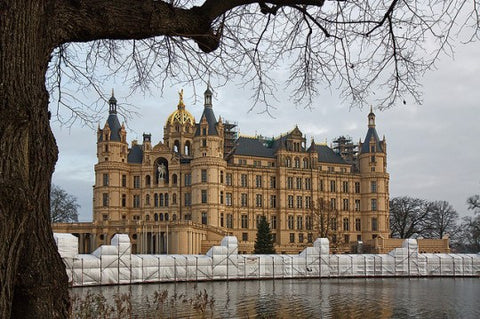
Schwerin Castle located near Meclenburg in the old East Germany is a fairytale Castle set on a small island in a lake within the city of Schwerin. For many years the Castle was home to the Dukes and Grand Dukes of Mecklenburg. The Castle currently serves as the seat of the state parliament for the state of Meclenburg-Vorpommern. The Castle dates to the 10th century when first reports of a castle in the locale are recorded in 973. The Polabian Slavic tribe founded a fort for defence on the strategically situated island.In 1160, the fort became a target of Germanic noblemen planning to expand their territory eastward under the leadership of Henry the Lion (1129–1195).However, the German conquerors recognised the strategic and aesthetically interesting location of the island and started building a new fort.
The foundation of the city of Schwerin took place in the same year. Schwerin became seat of a bishopric.In 1167, Henry gave the County of Schwerin to his vassal Gunzelin von Hagen, and the rest of the country around the city was returned to Niklot's son Pribislav, forming a ducal hereditary line that lasted until 1918. Under Duke Johann Albrecht I. (1525–1576), the fort became a castle, and the defensive functionality of the fortress was replaced with ornamentation and concessions to comfort. The use of terracotta during the Renaissance was dominant in North German architecture, and Schwerin's terracotta was supplied from Lübeck. Johann Albrecht rebuilt the chapel in the castle in 1563 and it became the first protestant church in the state. . The architecture was inspired by churches in Torgau and Dresden. The Venetian Renaissance gate, its gable showing the carrying of the cross, was made by Hans Walther (1526–1600), a sculptor from Dresden.Windows on the northern face show biblical illustrations by well-known Dutch artist Willem van den Broecke (called "Paludanus") (1530–1580).
The foundation of the city of Schwerin took place in the same year. Schwerin became seat of a bishopric.In 1167, Henry gave the County of Schwerin to his vassal Gunzelin von Hagen, and the rest of the country around the city was returned to Niklot's son Pribislav, forming a ducal hereditary line that lasted until 1918. Under Duke Johann Albrecht I. (1525–1576), the fort became a castle, and the defensive functionality of the fortress was replaced with ornamentation and concessions to comfort. The use of terracotta during the Renaissance was dominant in North German architecture, and Schwerin's terracotta was supplied from Lübeck. Johann Albrecht rebuilt the chapel in the castle in 1563 and it became the first protestant church in the state. . The architecture was inspired by churches in Torgau and Dresden. The Venetian Renaissance gate, its gable showing the carrying of the cross, was made by Hans Walther (1526–1600), a sculptor from Dresden.Windows on the northern face show biblical illustrations by well-known Dutch artist Willem van den Broecke (called "Paludanus") (1530–1580).

castle kitchen and that above the chapel were razed and replaced with Dutch Renaissance style facades in the 1630s. In the nineteenth century Grand Duke Friedrich (1800–1842) decided to rebuild the castle, and ordered his architect Georg Adolph Demmler (1804–1886) to do so. A few months later, construction was halted by his successor, Friedrich Franz II (1823–1883), who wanted a complete reconstruction of the historic site. Only some parts of the building from the 16th and 17th century were kept. Dresden architect Gottfried Semper (1803–1879) and Berlin architect Friedrich August Stüler (1800–1865) could not convince the grand duke of their plans. Instead, Demmler included elements of both of them into his plan, but would find inspiration in French Renaissance castles. It became the most admired master work of the student of Karl Friedrich Schinkel.. He also planned a government building in 1825-26 located at Schlossstraße (today the State Chancellery).His successor Stüler, again, changed a few things, and included a statue of Niklot on horseback, and the pompous cupola.
For the interior design, Heinrich Strack (1805–1880) from Berlin was chosen. There was a fire in the castle in December 1913. The revolution in 1918 resulted in the abdication of the Grand Duke, but only the exterior reconstruction had been completed. It later became a museum and in 1948 the seat of parliament. The German Democratic Republic, opposed to nobility, used it as a college for kindergarten teachers from 1952-1981. Then it was a Museum again until 1993. The Orangerie had been a technical museum since 1961. From 1974 on, some renovated rooms were used as an art museum. Since late 1990, it is once again a place of government and representation as the seat of the parliament of State of Mecklenburg-Vorpommern. Since then, massive renovation efforts have been conducted and are, due to the complexity of a castle of this size, still in progress.
For the interior design, Heinrich Strack (1805–1880) from Berlin was chosen. There was a fire in the castle in December 1913. The revolution in 1918 resulted in the abdication of the Grand Duke, but only the exterior reconstruction had been completed. It later became a museum and in 1948 the seat of parliament. The German Democratic Republic, opposed to nobility, used it as a college for kindergarten teachers from 1952-1981. Then it was a Museum again until 1993. The Orangerie had been a technical museum since 1961. From 1974 on, some renovated rooms were used as an art museum. Since late 1990, it is once again a place of government and representation as the seat of the parliament of State of Mecklenburg-Vorpommern. Since then, massive renovation efforts have been conducted and are, due to the complexity of a castle of this size, still in progress.


